Articles
| Name | Author | |
|---|---|---|
| CASE STUDY: Virgin Atlantic increases fuel efficiency gains with a pilot-first behavior solution | Jason Read, Manager Flight Operations Engineering & Efficiency, Virgin Atlantic | View article |
| CASE STUDY: Cathay’s Electronic Flight Folder built by pilots for pilots | Captain James Toye, Head of Line Operations, Cathay Pacific Airlines | View article |
| CASE STUDY: Southwest Airlines upgrades flight planning and flight management | Jennifer Paine, Managing Director Technology, Southwest Airlines | View article |
| CASE STUDY: SunExpress implements a new EFB and a new OS | Orhun Sezgin, EFB Specialist, SunExpress | View article |
| CASE STUDY: AI-Powered Solutions as the Key to Operational Efficiency and Sustainability at Flair Airlines | Flair Airlines | View article |
CASE STUDY: Virgin Atlantic increases fuel efficiency gains with a pilot-first behavior solution
Author: Jason Read, Manager Flight Operations Engineering & Efficiency, Virgin Atlantic
Subscribe
Jason Read, Manager Flight Operations Engineering & Efficiency at Virgin Atlantic describes a behavioral science-driven solution to fuel efficiency and emissions reduction
The main theme of this article is how Virgin Atlantic’s successful implementation of a behavioral science application has motivated our pilots to be more fuel efficient and produced significant fuel savings. But before that, I’ll give readers a brief introduction to Virgin Atlantic and an overview of our approach to fuel efficiency more generally to demonstrate how Signol fits in and enhances existing initiatives.
FUEL EFFICIENCY AT VIRGIN ATLANTIC
Virgin Atlantic airline is based in the UK, and its operations are all long-haul. The fleet includes about 40 wide-body aircraft, including Airbus A350-1000, A330-300 and neo, plus Boeing 787-9. Like all aviation companies, we have a target to meet net zero by 2050 and, as we are a long-haul airline, most of that will be achieved by increasing our use of SAF (Sustainable Aviation Fuel), alongside continued fleet transformation and pursuing greater operational efficiency.
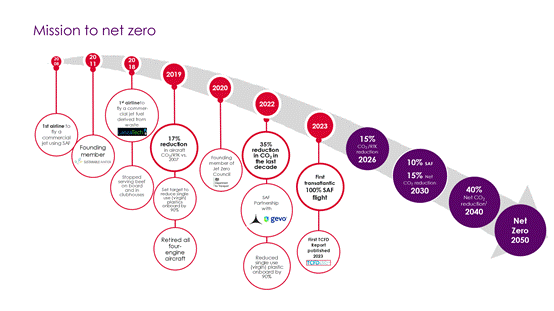
Figure 1
Virgin Atlantic is probably at the forefront of using SAF (figure 1). In 2008, we were the first airline to fly a jet airliner with part SAF, and in 2023 we were the first airline to fly a commercial airliner across the Atlantic fueled with 100% SAF. This flight managed to reach key results (like a 64% reduction in CO2e) with no engine modifications and no aircraft modifications, but as a fully drop-in solution. We’ll continue increasing our proportion of SAF and reducing our CO2 emissions through a process of fleet transformation, which has included retiring all of our four-engine aircraft in 2019; we’ve now got one of the newest fleets in the world. That fleet transformation will continue, and we’ll also pursue operational efficiencies to meet our targets.
There is already a fuel efficiency program in Virgin Atlantic, and we have looked at fuel efficiency across the whole flight for many years now, including ground operations, flight planning and in-flight optimizations such as up-linking wind data and temperature data – more examples in figure 2.
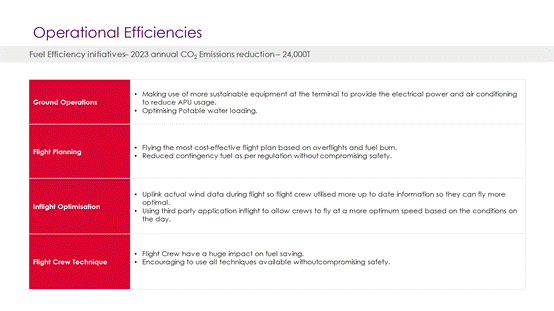
Figure 2
THE BEHAVIOR SCIENCE OPPORTUNITY WITH SIGNOL
We rely on pilots to adapt and optimize their behavior given the particular conditions they are experiencing, so pilot engagement is a core part of our fuel efficiency program. But as readers will understand, flight and crew engagement can be very challenging, particularly since they are a remote workforce. Here are some of the techniques we use at Virgin Atlantic (figure 3).
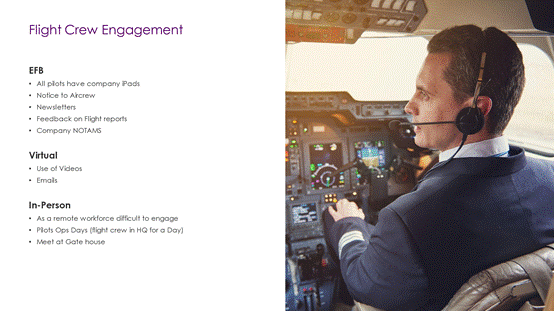
Figure 3
Like many airlines, all Virgin Atlantic pilots have an iPad; we can send them notices and newsletters, and they can send us feedback on eForms, etc. That’s quite an effective way of getting feedback from them. We also produce a fuel efficiency bulletin every quarter to give them an update on all the initiatives that we are doing as a company, as well as how they’re doing. Still, it is all anonymous, so we can’t interact with individual pilots through that. We wanted to explore the opportunity to engage pilots directly using behavioral science and understand how this could enhance our fuel efficiency initiatives and ultimately increase fuel savings.
In 2014 we collaborated with behavioral researchers and analysts associated with Signol in a study which tested different behavioral science techniques and how those can influence pilots’ fuel-saving behavior. The research showed that changes in pilots’ behavior over the eight-month study period led to both lower CO2 emissions (by 21,500 metric tons) and an estimated $5.4 million reduction in fuel costs.
Following the research, Signol went on and digitized the behavior change service into a software platform. At the end of 2021, we signed up with Signol to harness the fuel-saving opportunity already identified by the joint study. In the first month, we selected a few pilots to enroll to iron out all the bugs and get feedback from them; then we rolled it out to the rest of the pilot workforce. Within the first 18 months, we managed to reduce our fuel burn by 0.7 percent. Improvements are continuing and we are working with Signol to keep refining the program.
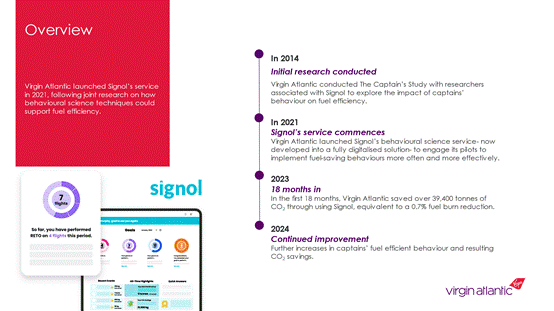
Figure 4
HOW SIGNOL REDUCES FUEL CONSUMPTION AND CO2 EMISSIONS
Signol is a communication service and software application. It combines our operational data with data analytics and behavioral science to evaluate the implementation of fuel-saving techniques while motivating and encouraging flight crew to act on those opportunities (figure 5).
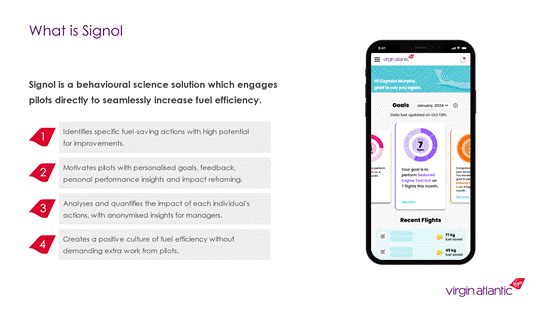
Figure 5
Signol leverages advanced data analytics to convert Virgin Atlantic’s raw fuel-related operational data into 18 behavioral change techniques (examples in figure 6) including providing each pilot with performance feedback on their fuel-saving practices. We, the flight operations managers, can access aggregated, anonymized summaries that reflect the overall efficiency of the crew. This approach empowers individuals to improve performance and supports a broader culture of sustainable, data-informed decision-making at the individual level.
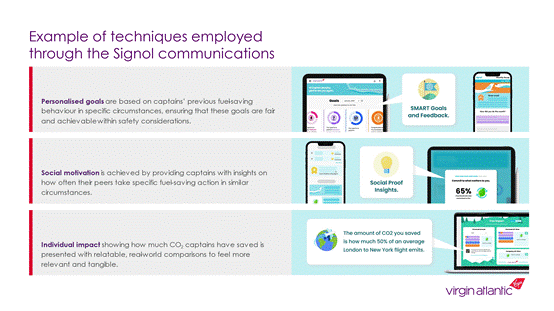
Figure 6
All Virgin Atlantic captains receive personalized fuel-saving goals which are based on analysis of their previous behavior, and we ensure that these goals are achievable while maintaining safety and accounting for varied circumstances. Social motivation is used to highlight that others achieve fuel savings in similar circumstances, which reminds captains that they can also implement this specific behavior at the next relevant opportunity.
By providing insights directly to captains on their personal impact, framed in relatable terms, users remain highly engaged. All these techniques have resulted in a very high email open rate; around 80% after a year and a half in. This indicates that our captains continue to interact with Signol’s service and value it. Since email is an important channel for communicating with pilots and delivering behavior change techniques, users’ continued engagement with Signol’s emails maintains the opportunity for behavior improvements.
IMPLEMENTING SIGNOL’S PILOT-FIRST APPROACH
As you can imagine, if a solution is using pilots’ personal data, you have to talk to the unions, especially in the UK. Signol actually did a lot of this work for us. They consulted with representatives from leading unions, including BALPA in the UK, and representatives from Virgin as well, including some who weren’t even part of the original study, to address questions around safety and data usage (figure 7).
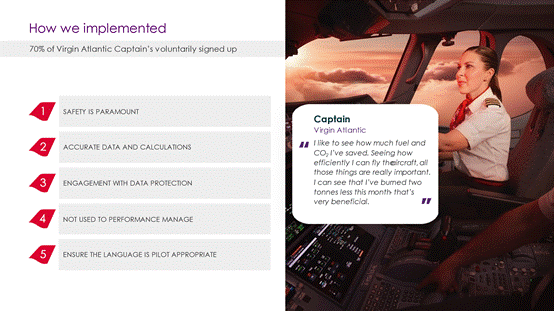
Figure 7
Discussions centered on how Signol’s service would prioritize safety, considering that, in reality, not all fuel-saving techniques can be used on every single flight. For example, we wouldn’t expect pilots to reduce discretionary fuel use in dangerous weather conditions. Signol addresses this by building exclusions into the pilots’ goals and providing them with opportunities to share notes on why a particular fuel-saving technique was not possible in those circumstances. Other considerations included avoiding leaderboards, not gamifying the service, and preserving anonymity. Signol’s service ticks all those boxes and we do not use performance management techniques like this. We ensure that Signol, Virgin and unions are all in agreement about how to prioritize data protection and we demonstrated that all GDPR concerns were addressed since Signol emails captains directly.
Data accuracy is another important aspect since the pilots can actually see the specific data of their flight. If this is not accurate, they’ll lose confidence, and that will negate the effectiveness of the service. We work with Signol to ensure the data available through Signol is all accurate and very similar to what pilots can see on the aircraft. Another decision which resulted from union discussions is that captains voluntarily sign up for the service; we didn’t impose the requirement to sign up. About 70 percent of captains at Virgin Atlantic have voluntarily signed up for the service at the time of writing, which is a good proportion.
Finally, we addressed unions’ concerns around whether personalized goals could be seen as unfair since some pilots have ‘easier-to-reach’ targets. To establish personalized goals, we look at the previous data, and then we implement slightly better goals, so we make sure that they can be achieved by the individual. Pilots understand that their personal targets are different from other people’s targets, but they don’t know anyone else’s specific targets or fuel-saving scores and we don’t see them either; only Signol knows. This helps create a positive culture of realistic fuel-saving rather than a culture of comparison. There are no financial incentives for pilots to save fuel. Similarly, pilots are not held responsible if they fail to meet fuel-saving targets.
SIGNOL’S IMPACT: INCREASED FUEL-SAVING IN FOUR AREAS
Across the first 18 months of using Signol, we managed to save 39,000 tons of CO2e, and we are engaging more of our pilots all the time. We have seen pilots increase their fuel-saving behavior in the four areas Signol addresses for Virgin: optimizing discretionary fuel load, implementing reduced engine taxi in and out procedures, and burning less fuel than the flight plan.

Figure 8
Readers will know that there are many factors affecting fuel burn that are outside of flight crew control so Signol’s analysis of the change in behavior and fuel saving takes into account as many relevant factors as possible. As you can see, the results show the difference between pre-Signol and post-Signol is an increase in all of these behaviors. Since there are a lot of things that affect fuel burn, it’s quite challenging to specifically find out the reason why that fuel burn has changed. So, Signol uses a method called econometrics that essentially removes all of the factors that affect fuel burn but are independent of Signol – different aircraft types, different routes, different calendars, etc., in order to isolate the crew’s impact on fuel consumption in a comparison between pre-Signol and post-Signol.
Signol also uses other analysis methods to see the change in individuals’ behavior in each of the four areas. For example, we see for Reduced Engine Taxi In (RETI) how each captain’s behavior changed from the baseline after they registered with Signol (figure 9).
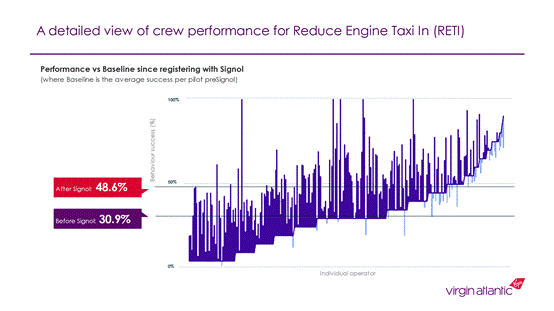
Figure 9
As you can see, most of the captains have improved their implementation of this fuel management technique, representing around an 18% increase on average. However, some of the top performers have actually decreased in their RETI implementation. This is mainly due to circumstances that decrease the number of opportunities pilots actually had to implement this fuel-saving technique. Because we’re a long-haul, our pilots only fly about 10 times a month – not that often. And if you remove all the occasions when external factors prevented a pilot from successfully implementing RETI, the data set gets very small, and there’s a lot of noise. This is called regression towards the mean. This is why Signol’s econometric analysis is a useful method for understanding the overall impact and net fuel savings, alongside looking at individual behavior change like in the graph above.
WHAT WE’VE LEARNT WITH SIGNOL
In summary, we’ve used Signol for three years now and have achieved impressive results (figure 10).
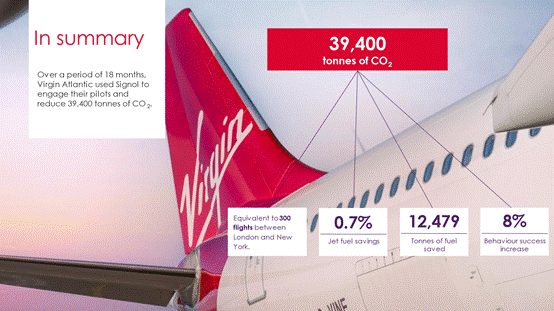
Figure 10
Now, the question is: how do we continue to improve on this and continue to reap the benefits of using Signol? Normally, if you implement anything, after a time, engagement fades away or the impact plateaus. We have had an opportunity to learn what happens when Signol pauses its service for a period, when we had to undergo a massive data change at Virgin Atlantic because we were changing our operational and crewing systems. Since we weren’t able to send data to Signol for quite a while until the new operational and crewing systems were migrated over, this allowed us to learn more about the lasting impact Signol has on the captains’ fuel efficiency behavior even when it is not active (figure 11).
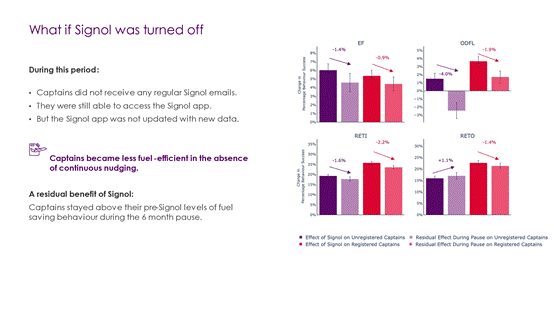
Figure 11
During that time, Signol wasn’t sending any emails to captains, so they weren’t being nudged to be more fuel-efficient in a targeted way. None of the data in the app was being updated, but captains could still go into the app if they wanted to. The graphs on the right of the figure show a reduction in fuel-efficient behavior while Signol was turned off, but that behavior remained higher than the pre-Signol levels, so there was still some residual effect there. For Virgin, this reinforced that it’s very important to keep using Signol to proactively and directly engage pilots to keep improving fuel efficiency behavior.
On another note, our work with Signol has shown how important it is to involve pilot unions early in any project which uses pilot data and individual performance insights. Luckily, Signol has done a lot of this work before, and they continue to engage with a lot of pilot unions on questions about safety and data protection.
Getting pilots onside and instilling confidence in a new initiative like Signol is also crucial. If you implement something that’s wrong, pilots will lose confidence very quickly. If one person loses confidence, it will be communicated to the rest of the pilot community very quickly. At Virgin Atlantic there’s a pilot WhatsApp group where information spreads like wildfire, so we made sure that all pilots’ concerns were addressed very early on. Working with Signol has highlighted the importance of communicating with pilots in the right way – ensuring that we don’t talk down to pilots, recognizing that they’re professionals and know how to fly. Signol’s product reflects continuous research and interviews with pilots, which ensures that the language is appropriate and it’s not condescending.
WHAT’S NEXT FOR VIRGIN AND SIGNOL?
As already mentioned, we’re still working with Signol and continuing to adapt the service to our needs, including refining the ‘efficient flight’ behavior to account for more factors and exploring whether to use auto-enrollment for new users, who can still opt-out of the voluntary initiative. We’re looking to see if we can include first officers into Signol’s service, since we believe that first officers have a big influence on the fuel efficiency of the whole flight; they probably affect the behavior of the captain as well.
We have opportunities to use an additional behavior change techniques: prosocial incentives i.e. charitable donations Virgin would make to causes pilots care about to reward users for reaching their fuel-saving goals. This technique was included in the original 2014 research, and we are now looking into using it as part of the current service while ensuring that using incentives does not undermine safety in any way.
I hope that you’ve found Virgin’s experience with Signol informative and, especially if you are planning a similar implementation in your airline, that it can contribute to your research.
Comments (0)
There are currently no comments about this article.

To post a comment, please login or subscribe.